Hugo Holden
Veteran Member
@Hugo Holden and @yogi63 I'm about to join the clu on the AIM-65 and I'd like to build myself a video board. Has there been any further development on this project over the last couple of years? Jörg are your gerbers still available? I'll probably layout my own board, but having a working example to start with could be useful.
Also, any better copies of the schematic than the rough PDF on the first page of this thread? It's not the easiest thing to read, though most of it is self explanatory.
Scott
There was a booklet published by Rockwell on the RM-65 video card, which included the schematic. I could never find it, in the flesh, so I had to rely on the photocopies to compare it with the pcb tracks that I drew as a .jpg file from the very helpful images and X-Rays of an original board that @dfnr2 provided. By the way, without his dumps of the ROMs, this project would have been impossible, so he deserves the Lion's share of the credit for the project.
Has anyone ever helped you re-create a vintage pcb by providing X-Rays ? I don't think so, as Detective Monk might say, but @dfnr2 did, he did this, to help solve the mysteries in a 4 layer pcb. This was my first attempt at replicating a 4 layer pcb.
It was a very long road to create the replica pcbs.
But as noted, the conversion of the the .jpg files I made into Altium pcb files was done at my pcb maker. I could not use these files in any way to create Gerbers because I do not have Altium software and cannnot even open those files.
Interestingly, Altium has just been acquired by the Japanese company Renesas for 9 Billion dollars.
Jorg used my drawings to create Gerbers, I have not checked these against my pcb artwork, but I think likely they are excellent, so if you want to make an RM-65 video card, this is the way to go.
For my AIM-65 I configured into a base with an orange transparent acrylic top, to support the adapter & video card. Also with a copy of the software code on the base to activate it. But also I put this code into a ROM, to be able to quickly activate the card:
Attachments
Last edited:







